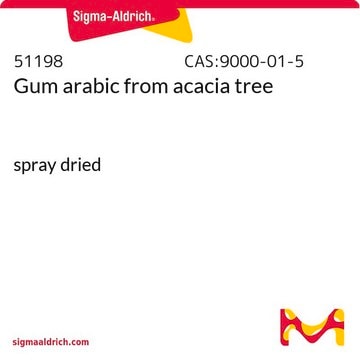G9752
Gum arabic from acacia tree
branched polysaccharide
Sinônimo(s):
Acacia gum
Faça loginpara ver os preços organizacionais e de contrato
About This Item
Produtos recomendados
fonte biológica
plant (Acacia)
forma
powder
cor
white to faint beige
temperatura de armazenamento
room temp
Procurando produtos similares? Visita Guia de comparação de produtos
Categorias relacionadas
Descrição geral
Gum arabic from acacia tree is extracted from the branches of Acacia senegal and Acacia seyal trees. It is an edible dried gummy exudate. Gum Arabic has high solubility and is used in food industry as a stabilizer, emulsifier, flavouring agent, thickener and surface-finishing agent. It initiates turbidity or hinders sugar crystallization. Gum arabic inhibits color pigmentation and protein precipitation in wine production.
Aplicação
Gum arabic from acacia tree has been used:
- as an emulsifying agent to determine lipase activity in shrimps
- for the visualization of mossy fiber sprouting
- as an immunogen and for coating microtitre wells in plate-trapped antigen ELISAs (PTA-ELISAs)
- for silver enhancement for immunohistochemistry
- as a component for Timm′s staining solution
- in nitrocellulose-based soil adhesion assay
- to separate few-layer graphene (FLG) from bulk graphite layers
Outras notas
Believed to be a branched polymer of galactose, rhamnose, arabinose, and glucuronic acid as the calcium, magnesium, and potassium salts with a mol. wt. of approx. 250,000.
To gain a comprehensive understanding of our extensive range of Polysaccharides for your research, we encourage you to visit our Carbohydrates Category page.
Código de classe de armazenamento
11 - Combustible Solids
Classe de risco de água (WGK)
WGK 3
Ponto de fulgor (°F)
Not applicable
Ponto de fulgor (°C)
Not applicable
Equipamento de proteção individual
dust mask type N95 (US), Eyeshields, Gloves
Certificados de análise (COA)
Busque Certificados de análise (COA) digitando o Número do Lote do produto. Os números de lote e remessa podem ser encontrados no rótulo de um produto após a palavra “Lot” ou “Batch”.
Já possui este produto?
Encontre a documentação dos produtos que você adquiriu recentemente na biblioteca de documentos.
A quantitative method for the high throughput screening for the soil adhesion properties of plant and microbial polysaccharides and exudates
Akhtar J, et al.
Plant and Soil, 1-9 (2018)
Purification and characterization of an intracellular lipase from pleopods of whiteleg shrimp (Litopenaeus vannamei)
Rivera-Perez c, et al.
Comparative Biochemistry and Physiology. Part B, Biochemistry & Molecular Biology, 158(1), 99-105 (2011)
Xenograft of human umbilical mesenchymal stem cells from Wharton?s jelly as a potential therapy for rat pilocarpine-induced epilepsy
Huang P, et al.
Brain, behavior, and immunity, 54(3), 45-58 (2016)
Acacia gum: History of the future
Sanchez C, et al.
Food Hydrocolloids, 78, 140-160 (2018)
Intra-amygdaloid injection of kainic acid in rats with genetic absence epilepsy: the relationship of typical absence epilepsy and temporal lobe epilepsy
Gurbanova AA, et al.
The Journal of Neuroscience, 28(31), 7828-7836 (2008)
Nossa equipe de cientistas tem experiência em todas as áreas de pesquisa, incluindo Life Sciences, ciência de materiais, síntese química, cromatografia, química analítica e muitas outras.
Entre em contato com a assistência técnica








